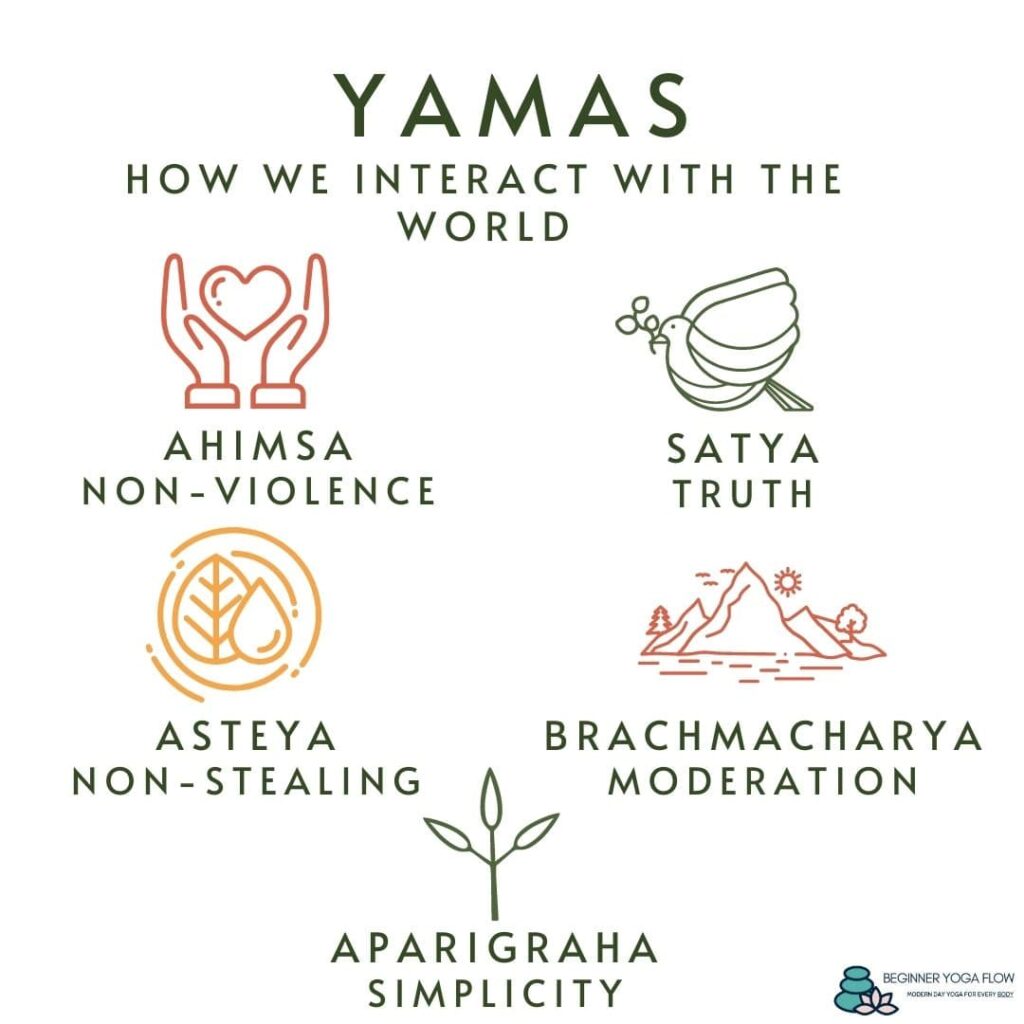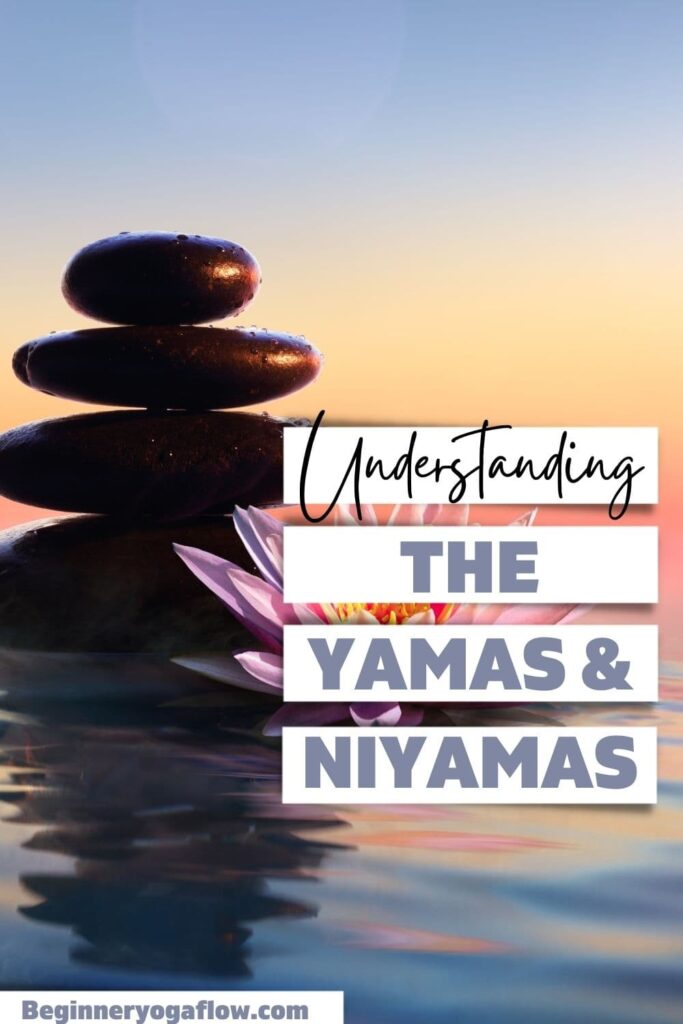This post contain affiliate links. Please read our affiliate disclosure here.
As detailed by Patanjali in the Yoga Sutras, there are 8 limbs of yoga on the path to enlightenment. Of those 8 limbs asana and pranayama are the most practiced of the 8 limbs. However, yoga is more than just a physical practice. Yoga begins with the Niyamas and Yamas.
Yoga has a strong philosophical foundation that begins with the Yamas and the Niyamas. These philosophies help to guide us in the ways we interact with the world and how we interact with ourselves. They are just as important as our asana practice and lay the groundwork for the remaining six limbs of yoga.
Yamas
The 5 yamas are the moral and ethical guidelines by which a yogi conducts themselves in the world. They are the principles which can guide us to live a conscious and honest life.

Ahimsa (Sutra 2.35)
Ahimsa is the practice of non-violence or non-harming. This is more than just physical violence but instructs us to be gentle in our actions, thoughts and speech. This principle instructs us to practice compassion and love but in a way that honors our truth as well. Ahimsa also means creating boundaries for ourselves and saying no with compassion and love that respects our own energy.
Satya (Sutra 2.36)
Satya seeks for us to be truthful in our speech, thoughts and dees. This honesty must come from a place of compassion and love. Be careful of being brutally honest. If your honesty is coming from a place of love then this is practicing Satya. This also means living your truth. When living honestly and authentically you cultivate respect and integrity and treat others with respect and integrity,
Asteya (Sutra 2.37)
Asteya is the practice of non-stealing. This means not taking physical items that are not ours but it also extends to our thoughts, actions and words. It also means letting go of competition and not always wanting what others have. This yama seeks to have you stop trying to “keep up with the Joneses”. While this yama may seem like the easiest yama to practice it can in fact be the most challenging for many of us. Here is an example of this concept of non-stealing as it relates to non-physical items. At night when a parent is reading a bedtime story to their child but in the back of their mind they are running through all the things and they rush through bedtime in a distracted way they are actually stealing from their child. They are taking away their full attention from their child and stealing precious moments with their children from themselves.
Brahmacharya (Sutra 2.38)
Brachmacharya teaches us “everything in moderation”. This means no overindulgence in sensual pleasures. This is more than just sex and extends to food, television, Instagram, excercise and anything we do in excess to fill our spiritual emptiness. By practicing restraint we leave space in our spirit so we can connect us to with God. This also means making peace with our cravings in order to stay connected with God.
Aparigraha (Sutra 2.39)
Aparigraha guides us to consume less. By living simply and getting rid of all the extra stuff in our lives we can focus on our true selves. Through greed and coveting we are distracted by all the shiny things and loose connections with God or Source. Our desire to consume more than we need is connected to our ego.
Niyamas
Niyamas are how we interact with ourselves and helps us maintain a positive environment within which we can thrive.

Shaucha (Sutra 2.40-2.41)
Shaucha is about purity and cleanliness. This niyama is related to both external and internal cleanliness. This can mean a wide range of things including how we keep our house, what we put in our bodies or anything else we consume including media and relationships. Shaucha guides us in identifying bad habits that no longer serve us and through this new found purity we can move through life with ease and care.
Santosha (Sutra 2.42)
Santosha can be translated to contentment. This is all about accepting what is and being grateful for it. You can think of this as having and attitude of gratitude and letting go of expectations. When we practice Santosha we let go of any notions of “I’ll be happy when/if….”. It allows us to be happy with what we have right now.
Tapas (Sutra 2.43)
Tapas is described as discipline. It is the practice of both mental and physical discipline. Through discipline we can transform our lives. Perhaps that means being disciplined in our exercise plan in order to be able to feel healthier. Or perhaps this means more discipline in how we manage our time so we have more freedom to do the things we love.
Swadhyaya (Sutra 2.44)
Swadhyaya is the practice of self education and study. This Niyama instructs us to NOT accept things without questions but instead seeking out knowledge through reading and contemplation. Through this process of self education we can cultivate a strong sense of self awareness. We can practice Swadhyaya through reflection, meditation, and self observation. Through this process of self reflection we can learn to pause between a stimulus and response. Through Swadhyaya we are open to exploration from within.
Ishvara-Pranidhana (Sutra 2.45)
The simple definition of Ishvara-Pranidhana is Faith. Faith in something bigger than ourselves. This is all about our spirituality and our relationship with a higher power. Through the practice of Ishvara-Pranidhana we can be our best and live life fully and authentically.

How to Practice the Niyamas and Yamas
Practicing the Yamas and Niyamas is a lifelong journey. When you begin, pick one to focus on. Take some time to reflect on what it means and small ways that you can integrate it into your life. Know that this practice will never be complete.
One easy way to practice the yamas and niyamas is to integrate them into your yoga practice. Perhaps you choose to cultivate Tapas, or self-discipline, by committing to a daily yoga practice.
Or practice yoga without expectation or judgement, letting go of what you think your practice should be and just letting it be.
As you begin this journey, know that the yamas and niyamas are not about perfection. They are a means to help us cultivate self awareness and a deep connection with ourselves and our communities.
Ready to take a deeper dive into the Niyamas and Yamas?



